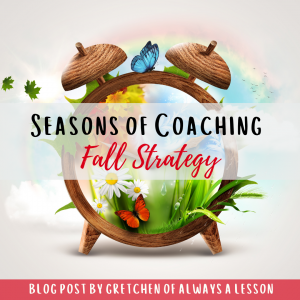Seasons of Coaching Blog Series: Fall Strategy
Having a coaching strategy ensures teacher leaders have a focus for how they support teachers. This thorough plan is aligned to state/district goals, school curriculum, and teacher needs and wants.
 However, having one singular coaching strategy for the year is not going to be responsive enough to grow teaching capacity to its potential. The seasons of coaching blog series will focus on how to shift your coaching strategy for the upcoming season (or quarter) of the year so that both teachers and students can experience maximum success. Grab the “Creating a Coaching Strategy Checklist” to help you prepare to implement the ideas below.
However, having one singular coaching strategy for the year is not going to be responsive enough to grow teaching capacity to its potential. The seasons of coaching blog series will focus on how to shift your coaching strategy for the upcoming season (or quarter) of the year so that both teachers and students can experience maximum success. Grab the “Creating a Coaching Strategy Checklist” to help you prepare to implement the ideas below.
To begin, your fall coaching strategy mimics the change of the season. Fall is full of a variety of colors. The back-to-school season creates a lot of variety in coaching tasks because of the hustle and bustle of getting the school year up and going. Therefore, a fall coaching strategy can also be referred to as colorful- being full of a multitude of (sometimes unrelated) tasks.
Just as trees shed leaves in the fall, coaches shed leadership strategies and approaches that didn’t work from the previous year. As we clean up the falling leaves in our yards, we must also clean up our coaching approach and space. This requires organization to clear the foundation so you can rebuild your strategy.
Build the foundation in four easy steps. Focus on people, information, learning, and strategy.
Step 1: People
Successful teacher leaders spend a majority of their role working with people. Navigating relationships and effective communication makes way for the strategy to come later. Spend time brainstorming a variety of ways to build relationships with those you serve. Any new staff members should be properly onboarded and acclimated to the school, grade level, or subject area. Ask those you support for their input before you even begin working together. Complete a quick staff survey on their impressions of their own teaching strengths and weaknesses as well as desired professional goals (and not just what the district of school says they should work on).
Step 2: Information
Teacher leaders will gather the information necessary to organize their space, bring clarity to staff on how the partnerships will work, and pave the path for a coaching strategy. Teachers need to understand the variety of supports they have on campus (ie. who to go to for what) and what the specific roles are in the collaborative partnership. Gathering this information is essential before diving into coaching.
Step 3: Learning
Providing learning opportunities is a major piece that drives the growth of both teachers and students. Designing a PD plan so that it aligns to district and state guidelines, school goals and initiatives, and teacher needs is essential. Laying out a monthly PD plan helps the topics flow from foundational to implementation. This calendar is helpful for both teacher leaders and those they support, so everyone is on the same page with the long-term plan. There should be space to build in options for topics of teacher interest that might not be covered under state, district, or school plans. These can be led by teachers themselves, but facilitated by teacher leaders. Most important though, is feedback from these learning sessions so all future sessions can be productive and of interest to teachers.
Step 4: Strategy
It’s now time to implement your fall coaching strategy. Teachers need to be aware of how they can partner together and you need a way to track who you work with, what you work on, and how they are improving. The first 30 days are most important so that the school year begins successfully. Meeting with administrators will help you prioritize your time and tasks. Then you can begin steps 1-3 above.
NEXT STEPS:
- Read the other blog posts in this series: Winter, Spring, and Summer.
- Want help establishing your foundation? Grab the printables for each step mentioned above in the Beginning of the Year Tools for Instructional Coaches.
- If you’re looking for guidance and feedback while you begin to implement your seasonal coaching strategy, join the Teacher Leader Mastermind! It’s a community of coaches nationwide that meet virtually to chat through obstacles, celebrate wins, and cheer each other on as we grow our leadership skills.
GO BE GREAT!


 Get Edu-Tips, Freebies and grab your FREE Study Guide for Gretchen’s New Book!
Get Edu-Tips, Freebies and grab your FREE Study Guide for Gretchen’s New Book!